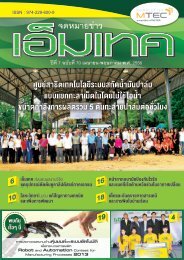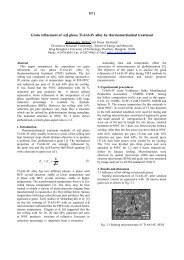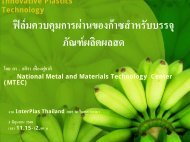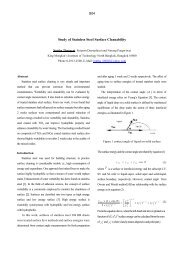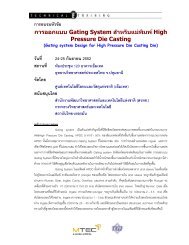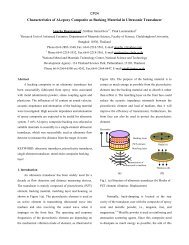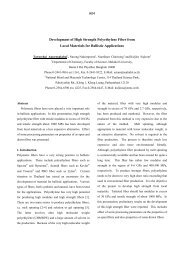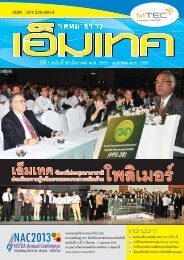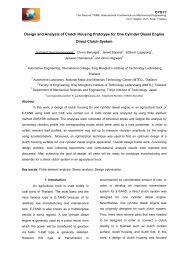EUROPEAN WHITE BOOK
EUROPEAN WHITE BOOK
EUROPEAN WHITE BOOK
Create successful ePaper yourself
Turn your PDF publications into a flip-book with our unique Google optimized e-Paper software.
ities, allowing the coding of hybrid assemblies presentinga spatial ordering at different length scales. Hybridons carryingchirality and/or dis-symmetry (Janus-type NBBs) andcomplementary functionalities will open new pathwaysfor the synthesis of these materials.With skilled chemists setting original pathways in materialsprocessing, numerous scientific breakthroughs can beexpected in this field. The synergy between chemistry andchemical engineering will permit an access to materialshaving complex structures that allow a high degree ofintegration. In particular, a synthesis obtained through theconstruction of materials by the simultaneous use of selfassemblingprocesses and morphosynthesis (exploitingchemical transformation in spatially restricted reactionfields) coupled with the use of external forces (such asgravity, electrical and magnetic fields, and mechanicalstress) or even through the use of strong compositional fluxvariations of reagents during synthesis (open systems) willallow the generation of innovative hierarchical structures.Chemical strategies offered by such coupled processes(self assembly + morphosynthesis + external solicitations)allow, through an intelligent and tuned coding, the developmentof a new vectorial chemistry that is able to direct theassembling of a large variety of structurally well-definednano-objects into complex architectures. Multiscale-structuredhybrids or inorganic networks (from nanometre tomillimetre) will open a land of opportunities for the designof new materials. Could these new synthesis strategiesallow us to dream of a future where it is possible to buildintelligent advanced materials that respond to externalstimuli, adapt to their environment, and self-replicate, selfrepair,or self-destroy at the end of their useful life cycle ?(c) Research needsSuch an innovative field of research will strongly benefitand become more mature through developments and advancesin the following areas:• Better knowledge of soft chemistry routes from precursorsto materials.• Improved knowledge of interfacial chemistry and physicochemistryof nanocomposites.• Study of phase diagrams of hybrid composites.• Better knowledge of organized-matter soft chemistry.• Study of order/disorder transition in hybrid nanosystems.• Relation between order and disorder and a given propertyof the hybrid (e.g., mechanical).• Better knowledge of reactivity, stability, and connectivityof NBBs.• Synthesis of new nano-objects and nanohybrids withtuned functionalities, with dissymmetric functionalitiesor carrying chirality.• Synthesis of nanoparticles with a controlled surfacechemistry, adjustable size, sharp- sized distribution, andredispersability.• Clean and environment friendly process.• Development of 2-D hybrid networks, lamellar, films, etc.• Development of bio-inspired materials.• Hybrid materials having modulable mechanicalproperties.• Development of materials that can adapt their responseto external stimuli (e.g., pH, solvent, light, external fields,temperature).• Smart functional coatings (highly hydrophobic or highlyhydrophilic, protective, anti-corrosion, anti-scratch, etc.).• Intelligent, hierarchically structured membranes thatcan couple separation and catalytic processes.• New adsorbants.• Hybrids for photonics having photochromic, emission,absorption, lasing, nonlinear optical, electroluminescentproperties for designing new sensors, optical memories,lasers, and display devices.• Development of biohybrids that will benefit fields, suchas biosensors, imaging, immunoassays, vectorizationwith controlled release, hybrids allowing better compactionand thus transport of ADN, protection of fragilebiocomponents, etc.1.4.4. Inorganic Amorphous Solids – GlassesBecause of their thermodynamic status as frozen liquids,glasses occupy a peculiar position in the general classificationof materials science. Above the so-called glass transitiontemperature, these metastable but extraordinary solidsexhibit temperature-dependent plasticity that allowsindustrially controlled operations such as blowing, fibering,and moulding. Under the same conditions, these metastablecompounds tend to come back to equilibrium innucleating microcrystals or molecules, forming vitroceramicsor foaming glasses. This situation could enhancesome properties, such as mechanical strength, but couldalso be detrimental to others, such as light propagation inoptics. The easy glass-forming ability is the privilege ofsome oxide families, such as the silicates, which allow usto prepare such sophisticated objects as optical fibres fortelecommunication and low-cost products for the automobileor building industry. From a purely marketing orpublic visibility point of view, these materials are the drivingforce of the research and glass industries.MATERIALS: SCIENCE AND ENGINEERING45



